Crown and bridge treatments are key for fixing teeth and making smiles look better. They help people who lost teeth because of decay or injury. Dental crowns cover damaged teeth, and dental bridges fill in gaps by attaching to healthy teeth.
In Turkey, many clinics provide top-notch care. They use materials like porcelain and metal for lasting results. Knowing about these treatments helps patients choose the best for their teeth.
Crown and bridge treatments are key in dentistry. They help restore smiles and dental function. These options fix damaged or missing teeth, improving looks and health. Knowing what crowns and bridges are and their roles in dentistry is vital.
Crowns cover a damaged tooth, protecting it and making it work again. They're used for teeth with severe decay, fractures, or wear. Bridges fill gaps from missing teeth with artificial ones, called pontics. These are held in place by crowns on either side.
Crowns restore a tooth's shape and strength, making it look better. They also protect against future damage. Bridges replace missing teeth, helping with chewing and keeping teeth in line. Both crowns and bridges are crucial for maintaining oral function and health.

The crown and bridge treatment process is detailed and precise. It starts with a consultation to check the patient's oral health. The dentist then talks about the best treatment options. Following the Crown Procedure Steps and Bridge Procedure Steps carefully is key to success.
The first step is tooth preparation. The dentist shapes the tooth to fit the crown perfectly. A digital impression is taken to make a custom restoration.
For the Bridge Procedure Steps, the teeth next to the affected one are prepared. This is to support the bridge. After preparing the teeth, a temporary crown or bridge is fitted. This is while the permanent one is being made.
Once the permanent crown or bridge is ready, the temporary one is removed. The final step is cementing the new crown or bridge in place. This gives both function and beauty.
Choosing the right materials is crucial. Porcelain is often used for crowns because it looks natural. Metals like gold or alloy are strong. Bridge materials are similar, offering durable solutions.
Hybrid materials that mix porcelain and metal are also available. They balance looks and durability well.
Knowing the different types of crowns helps patients make better choices. Each type has its own benefits. The main types are:

| Type of Crown | Aesthetic Quality | Durability | Cost |
|---|---|---|---|
| All-Ceramic | High | Moderate | High |
| Porcelain-Fused-to-Metal | High | High | Moderate |
| Gold | Low | Very High | High |
| Resin | Low | Low | Low |
Crown and bridge treatments bring many benefits to those looking to improve their dental health. These treatments do more than just make your teeth look good. They also make your teeth work better and last longer.
The main Benefits of Crowns and Bridges is Restoring Functionality. People can chew better, eat more kinds of food, and get more nutrients. This means you can enjoy your favorite foods without pain or trouble.
When it comes to Aesthetic Improvement, crowns and bridges are top-notch. They fix gaps, straighten teeth, and repair broken teeth. Thanks to modern materials, they look so natural that they boost your confidence and help you feel more comfortable around others.
Another big plus is the Longevity of Repair Work. With the right care, crowns and bridges can last over 10 years. This makes them a smart choice for your teeth. They not only reduce future dental problems but also keep your other teeth stable.
| Benefit | Description |
|---|---|
| Restoration of Functionality | Improved chewing and dietary options. |
| Aesthetic Improvement | Natural-looking results that boost confidence. |
| Longevity and Durability | Long-lasting solutions with proper care. |
Crown and bridge treatments are key for those wanting to fix their dental health and smile. They are important parts of restorative dentistry. They help fix lost or damaged teeth.
In this summary, we looked at how these treatments work. They improve both how teeth function and look.
For those looking into restorative dentistry in Turkey, many options are available. Reputable clinics offer these treatments. This ensures patients get top-notch care for their dental health.
Choosing the right dental professional is important. It means patients get the care they need with skill and care.
Knowing about crown and bridge treatments helps patients make better dental care choices. These treatments not only improve dental health but also overall well-being. They are a great option for anyone dealing with tooth loss or damage.
A dental crown is a prosthetic that covers a damaged tooth. It helps restore the tooth's shape and function. This is especially true for teeth weakened by decay or fracture.
A dental bridge fills gaps left by missing teeth. It has artificial teeth called pontics. These are held in place by crowns on nearby teeth, giving a natural look and feel.
There are several types of dental crowns. These include all-ceramic, porcelain-fused-to-metal, gold, and resin crowns. Each type is chosen based on the patient's needs and preferences.
Porcelain, gold, and metal alloys are common in crown and bridge treatments. They are chosen for their durability and beauty. Porcelain is especially popular for its natural appearance.
With proper care, crowns and bridges can last over a decade. They are a long-term investment for a healthy, beautiful smile.
Crown and bridge treatments restore chewing function and enhance appearance. They also prevent future dental problems, making them a valuable investment.
Most patients feel little to no pain during treatment thanks to local anesthesia. Any discomfort after is usually mild and can be managed with over-the-counter pain relievers.
To care for crowns and bridges, brush and floss regularly. Visit your dentist for check-ups. Avoid hard or sticky foods that could damage them.
Yes, many dental clinics in Turkey offer crown and bridge treatments. They use advanced techniques and materials for high-quality results, attracting both local and international patients.
The process starts with a consultation and tooth preparation. Digital impressions are taken, and a temporary restoration is made. Finally, the custom crown or bridge is cemented in place.
Keeping your teeth healthy is key, especially for kids and teens. They often get cavities because of the grooves in their teeth. Fissure sealants are a great way to protect these areas. They are clear or tooth-colored and block decay.
In Turkey, where cavities are common, fissure sealants are making a big difference. They help keep smiles healthy and reduce dental visits. Learning about fissure sealants can help you keep your teeth strong and prevent cavities for a long time.
Fissure sealants are key to keeping teeth healthy, especially for kids. They stop tooth decay by creating a protective layer. This part will look at what sealants are, how they work, and their many benefits.
Fissure sealants are thin plastic coatings put on teeth, mainly molars, to prevent decay. They block food and bacteria from getting stuck in tooth grooves. This makes them a great way to understand and use fissure sealants.
Applying fissure sealants is easy and done during dental visits. The dentist first cleans the tooth. Then, an acid solution is used, followed by the sealant bonding to the enamel. This quick process can last for years, helping keep teeth healthy.
Using fissure sealants has many benefits, especially in lowering cavity risk. Research shows they can cut cavity risk by up to 80% in molars. They are also cheaper than fillings and last a long time, making them a big plus for dental health.
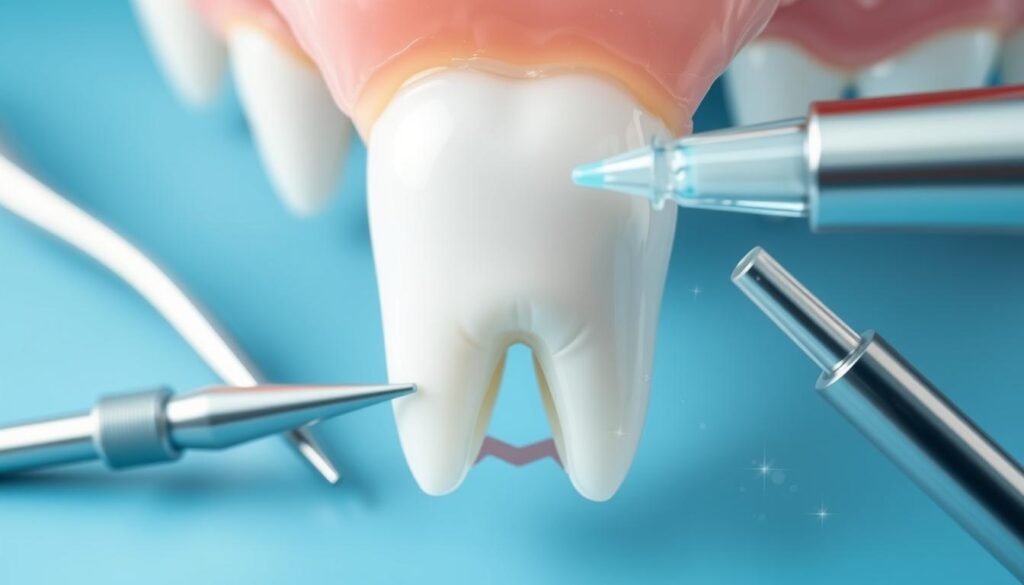
| Aspect | Details |
|---|---|
| Definition of Sealants | Thin plastic coatings for tooth surfaces |
| How Sealants Work | Create a barrier against food and bacteria |
| Benefits of Sealants | Reduces cavities by up to 80% |
| Durability | Lasts several years with regular checks |
Fissure sealants are key in stopping cavities, especially for certain people. Knowing who needs them, when to apply, and their long-term dental health benefits is important. This knowledge helps improve oral health habits.
Children and teens, especially those with new permanent molars, are top candidates for sealants. People with a history of cavities or poor oral hygiene also benefit. Dentists check who needs sealants the most.
The best time for sealants is when permanent teeth first appear, usually between 6 and 12 years old. This is when cavities are most likely to start. Dentists might also suggest sealants for adults with a high risk of cavities or deep grooves.
Using fissure sealants greatly improves dental health over time. Studies show a big drop in tooth decay among users. This can also save money by avoiding costly fillings or tooth removals. Sealants help keep teeth healthy and improve overall mouth health.
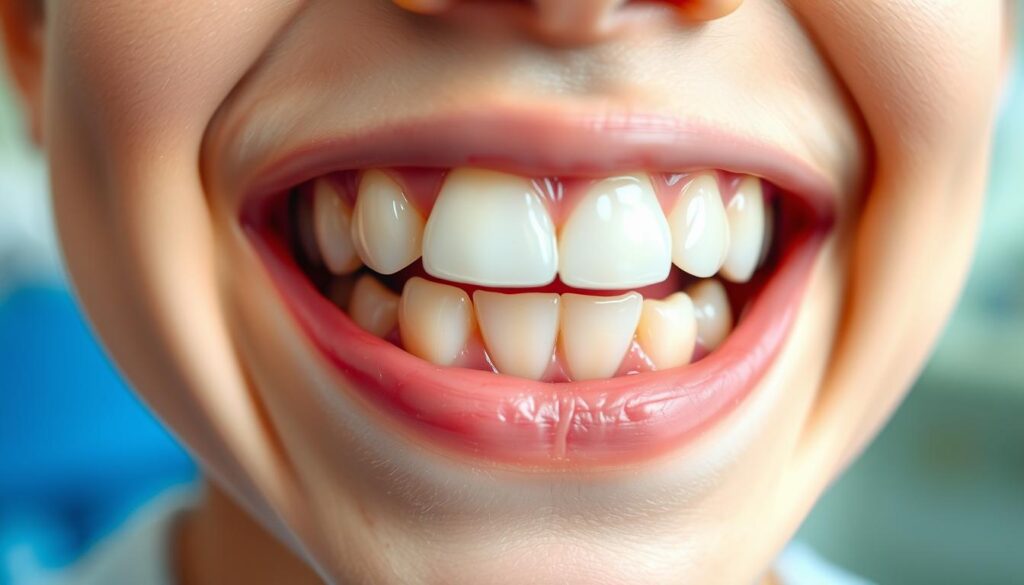
| Candidate Group | Recommended Age for Application | Potential Benefits |
|---|---|---|
| Children | 6-12 years | Reduced cavity risk, healthier teeth |
| Teenagers | 6-12 years | Lower dental treatment costs, preventive care |
| Adults | Varies | Protection for cavity-prone teeth, long-term dental health |
Fissure sealants are a great way to stop cavities, especially in kids and teens. They fill in the grooves and pits in teeth. This creates a barrier against harmful bacteria and acids.
Sealants do more than just prevent cavities. They also help keep teeth healthy. This can improve your life by making it easier to keep your teeth clean.
It's important to talk to a dentist in Turkey about sealants. They can help decide if they're right for you. Keeping sealants in good shape is crucial for them to work well.
Using fissure sealants is a smart move for your teeth. Knowing how important they are helps you make better choices for your dental health.
Fissure sealants are thin plastic coatings for teeth, mainly on molars. They block food and bacteria from getting stuck in tooth grooves. This helps prevent cavities.
Kids and teens with new molars are great candidates. Also, those with cavities, poor oral hygiene, or eat a lot of sugar. Dentists check your teeth to decide.
Apply them when permanent teeth come in, between 6 and 12 years old. This is when cavities are most common. Adults with cavity-prone teeth might also get them.
Sealants lower dental decay and save money over time. They keep teeth healthy. This means fewer fillings and extractions.
Sealants last several years. But, regular dental check-ups are key to make sure they're working.
Yes, they're safe for kids. The process is quick and doesn't hurt. It's a good way to keep teeth healthy.
Sealants can cut cavity risk by up to 80% in molars. They're very effective for kids and teens.
Yes, dentists might suggest them for adults with cavities or deep grooves. It helps keep teeth healthy.
Many people struggle to find good solutions for missing teeth. Dental implants have become a top choice. They work well and last a long time, just like natural teeth.
Unlike dentures and bridges, implants in Turkey are a permanent fix. This is thanks to advanced technology and expert care. In this article, we'll look into dental implants. We'll cover the different types and what the process is like.
Dental implants are a key solution for missing teeth and better dental health. They are titanium posts that act like natural tooth roots. Many people choose implants for their many benefits over other options.
A dental implant is a small, titanium post that's surgically put into the jawbone. It fuses with the bone, making a strong base for artificial teeth. The artificial tooth or crown is then attached to the implant, giving a natural and functional solution for missing teeth.
Choosing dental implants brings many benefits to a patient's life:
It's important to know the types of dental implants available:
| Type of Implant | Description | Ideal Candidates |
|---|---|---|
| Endosteal Implants | Surgically placed directly into the jawbone; most common type. | Patients with sufficient jawbone density. |
| Subperiosteal Implants | Placed under the gum but above the jawbone; for those lacking bone structure. | Patients with inadequate jawbone height. |
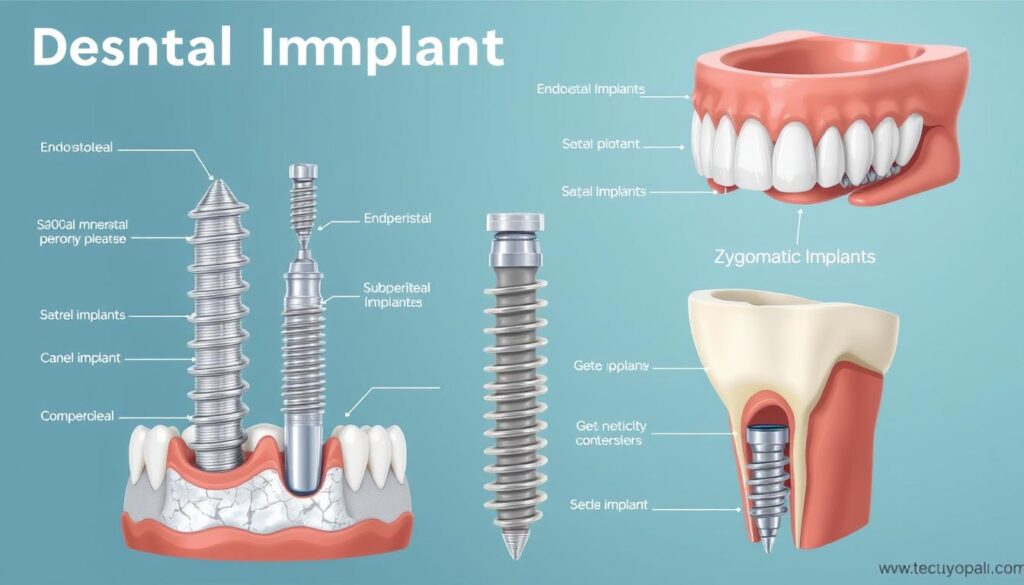
Dental implants are a reliable fix for tooth loss. Knowing about this process helps patients make better choices. It starts with a detailed check-up and scans to see the bone's health and shape. Then, a treatment plan is made just for you.
The first step is a consultation to talk about your health and what you hope for. Next, the implant is placed in the jawbone. This is followed by a healing period where the implant bonds with the bone.
After healing, abutments are added, and then crowns that look like your natural teeth. Keeping in touch with your dental team is key at every step.
Looking after your implants after surgery is very important. Good implant maintenance means brushing and flossing regularly. Also, don't forget to see your dentist for check-ups.
By following these steps, your implants can last for a long time.
The cost of dental implants in Turkey can change a lot. Things like the clinic's fame, where it's located, how complex the procedure is, and the materials used all play a part. Doing your homework on costs can help you make a smart choice for your teeth.
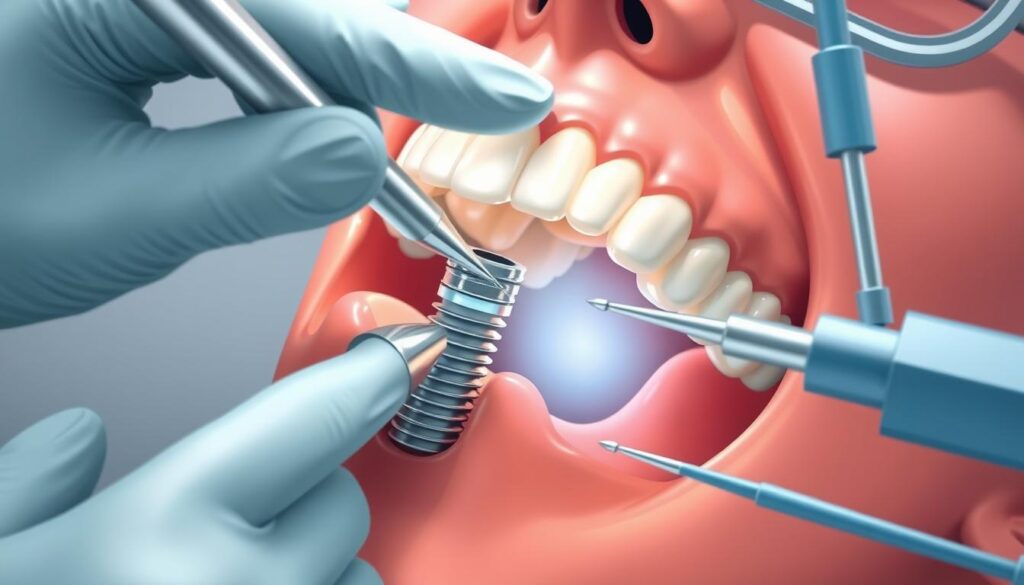
Dental implants are key in solving missing teeth problems. They not only fix the function of your smile but also make it look better. This boosts the confidence of those who have lost teeth.
They are durable, comfortable, and easy to care for. This makes them a top choice for many people.
It's important to take good care of dental implants to make them last. Regular dentist visits and good oral hygiene are essential. Getting dental implants in Turkey is a great option for quality care at good prices.
If you're looking to regain a full smile, talking to dental experts in Turkey is a good first step. They can help you every step of the way. This ensures a positive experience that improves your health and boosts your confidence.
Dental implants are titanium posts that are surgically inserted into the jawbone. They act as strong anchors for artificial teeth. This makes them stable and durable, just like natural tooth roots.
Dental implants look and feel natural. They are comfortable and improve your bite. They last longer than dentures or bridges, making them a better choice for missing teeth.
There are two main types of dental implants. Endosteal implants are placed directly into the jawbone. Subperiosteal implants are placed under the gum but above the jawbone. The right choice depends on your oral health and jaw shape.
Getting dental implants involves several steps. First, you'll have a consultation and imaging tests. Then, the implants are placed surgically. After healing, the final restoration is attached.
Keeping dental implants healthy is key. Brush and floss regularly. Visit your dentist for check-ups. Avoid smoking to prevent damage.
Yes, dental implant costs in Turkey vary. Factors like clinic reputation, location, and procedure type affect the price. It's wise to research and talk to professionals to understand costs.
Dental implants work for many, but not all. Your bone density, health, and medical conditions are important. A dentist will assess these before recommending implants.
Implants are more stable and permanent than dentures. They restore full tooth function without the need for adhesives. This makes them a reliable choice for missing teeth.
Recovery times vary, but it usually takes a few days to weeks. The healing phase, where the implant bonds with the bone, can take months.
Removable dentures are key for those looking to replace missing teeth. They boost both function and looks. In Turkey, dental care is easy to find, making these dentures a top choice for better oral health.
These dentures are known for being comfy, affordable, and effective. They can really change your life for the better. Let's dive into why they're such a great option.
Removable dentures are key dental tools that replace missing teeth. They help with chewing and make your smile look natural again. Made from top-notch materials, these dentures have artificial teeth that look real.
Removable dentures are made to solve tooth loss problems. They can be removed for cleaning, which is good for your mouth. They fit well and meet specific dental needs. You can choose from various styles based on your dental situation.
There are many types of removable dentures to fit different needs:
| Type of Denture | Description | Ideal For |
|---|---|---|
| Complete Dentures | Replace all missing teeth in the mouth. | Patients with complete tooth loss. |
| Partial Dentures | Fill in gaps created by one or more missing teeth. | Patients with some remaining natural teeth. |
| Flexible Dentures | Use thermoplastic materials; offer a comfortable fit. | Patients seeking enhanced comfort. |
Removable dentures bring many benefits that improve life for those without teeth. Knowing these advantages helps in choosing the right dental care.
How comfortable dentures are is key. Custom-made and fitted right, they let you eat a variety of foods without pain. New dental materials make dentures fit better, reducing irritation and sore spots.
This makes eating and socializing easier and more fun.
Removable dentures are good for your mouth. They stop nearby teeth from moving, which can cause more problems. They also keep the jawbone strong, helping your face look right.
Cleaning dentures is easy, which helps keep your mouth healthy.
Many people look for affordable dental options. Dentures are cheaper than implants and fit most budgets. Turkey has many dental clinics with good prices and payment plans, making dentures more accessible.
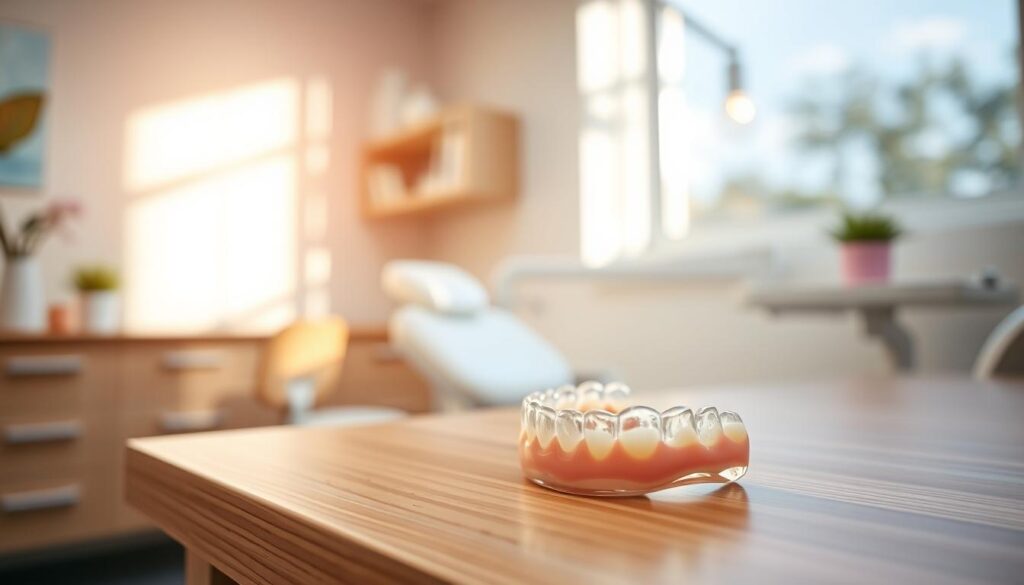
Starting your journey to find the right removable dentures begins with a dental consultation. A dentist will check your oral health and talk about what you prefer. They will then suggest the best dentures for you, making sure they fit well and feel comfortable.
Talking to a dental expert is key to making the right choice. They will look at your mouth and what you need for good dental care. They'll also listen to what you want in terms of looks and comfort. This helps pick dentures that fit your life and style.
When picking dentures, think about a few important things:
Talking over these points with a dentist helps you make a choice that meets your needs and wants.
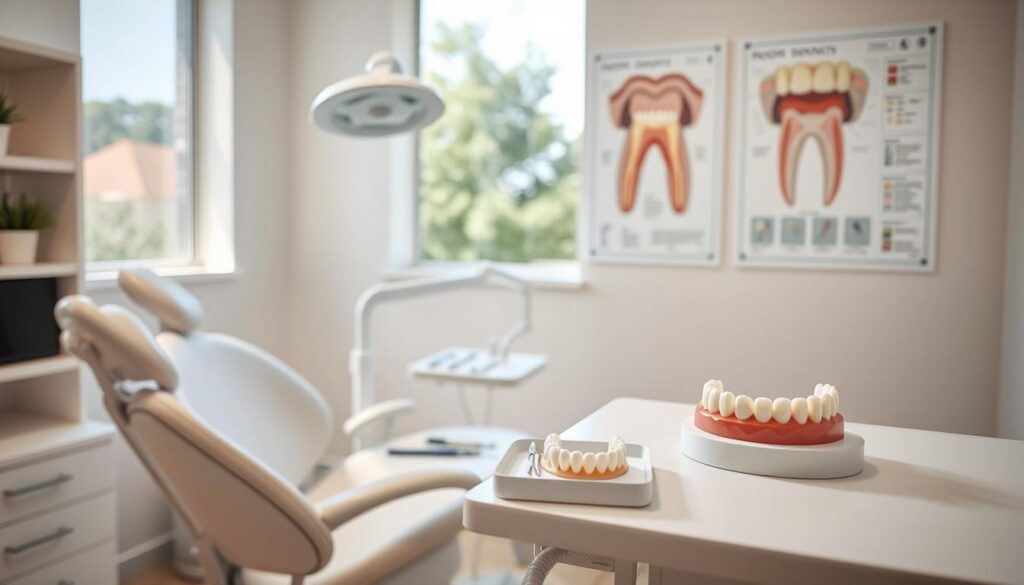
Removable dentures are a good choice for people who have lost teeth. They improve oral health and make eating and speaking easier. Plus, they are affordable, making them a popular option for many.
When picking dentures, talking to a dentist is key. They help match your needs with the right dentures. This ensures you get a solution that works for you.
Looking ahead, dentures remain a reliable option for those with tooth loss. Advances in technology and materials keep improving them. This makes dentures a big help in improving life quality.
Removable dentures are dental appliances that replace missing teeth. They can be taken out for cleaning and care. They are made from acrylic resin with artificial teeth that look natural.
To pick the right dentures, see a dental professional. They will check your teeth and talk about what you want. Think about how they look, cost, comfort, and how easy they are to care for.
There are two main types: complete dentures and partial dentures. Complete dentures replace all teeth, while partial dentures fill gaps. Flexible dentures, made from thermoplastic materials, are also available. They offer better comfort and fit.
Yes, removable dentures can be very comfortable. They allow you to eat different foods without pain. New dental materials help them fit well, reducing irritation and sores.
Removable dentures help keep your mouth healthy. They stop other teeth from moving into gaps, keeping your teeth in line. They also help keep your gums and jawbone healthy, which is good for your face.
Removable dentures are cheaper than dental implants. They are a budget-friendly option for replacing teeth. Many dental offices in Turkey offer good prices and payment plans.
To keep your dentures clean, remove them daily. Clean them with a soft brush and a gentle cleaner. Don't forget to take care of your gums and teeth too.
Yes, wearing dentures can help keep your jawbone and gums healthy. This helps keep your face looking good and your teeth in place.
Dental prosthetics are key in modern dentistry. They help people with missing or damaged teeth. These devices and techniques improve both function and looks.
It's important to know the different types of dental prosthetics. This helps find the best solution for each person. Options include removable prosthetics and new choices like dental implants and bridges.
Dental prosthetics are key in fixing both looks and function for those without teeth. They are artificial devices made to replace missing teeth, helping a lot with oral health. Knowing about the different types of teeth replacements helps patients choose the best dental solutions.
Dental prosthetics include many devices in prosthetic dentistry. They are mainly two types: removable ones like dentures and fixed ones like bridges and implants. These are made from materials like porcelain, acrylic, and metals, all chosen for dental needs. Each one is made to fix tooth function and improve life quality.
Dental prosthetics do more than just look good. They help a lot with keeping teeth clean and overall health. They stop other teeth from moving, which can cause problems. They also help avoid periodontal disease risks.
These devices make it easier to keep teeth clean. This makes dental care routines simpler for those who want to keep their teeth healthy.
Studies show that dental prosthetics boost self-esteem and life quality. They let people eat a wider variety of foods, improving their health.
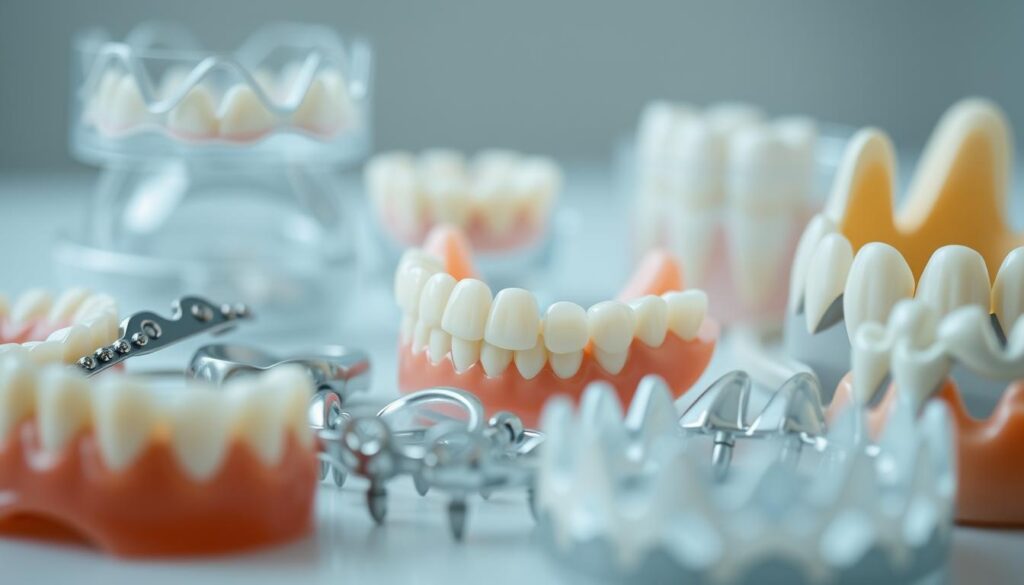
| Type of Prosthetic | Description | Benefits |
|---|---|---|
| Full Dentures | Removable prosthetics replacing all teeth in one jaw. | Enhances aesthetics, restores chewing function. |
| Partial Dentures | Removable prosthetics that replace some missing teeth. | Prevents shifting of adjacent teeth, improves speech. |
| Dental Bridges | Fixed prosthetics that connect to remaining teeth. | Restores function, provides stability. |
| Dental Implants | Surgically placed titanium posts acting as tooth roots. | Strong, permanent solution, closely mimics natural teeth. |
Dental prosthetics are key in fixing teeth loss. They come in many types, both removable and fixed. Each type meets different needs and tastes. Here are the main dental prosthetics for tooth loss.
Full dentures, or complete dentures, are for those who lost all teeth in one or both jaws. They look like real teeth and sit on the gums. There are two kinds: conventional, made after healing, and immediate, made right after tooth removal. Getting them to fit right is crucial for comfort and use.
Partial dentures are for those with some teeth left but missing others. They have fake teeth on a base that attaches to healthy teeth with metal clasps. They help keep the mouth looking good and working well, and stop other teeth from moving.
Dental bridges are fixed solutions for missing teeth. They attach to healthy teeth on either side of the gap. Bridges have fake teeth, or pontics, held by crowns. They fill gaps, improve chewing and speaking, and keep teeth in place.
Dental implants are top-notch for replacing teeth. They are permanent and involve titanium roots in the jawbone. After healing, crowns are put on, making them look and work like real teeth. Implants are good for looks and function, and help keep the jawbone strong.
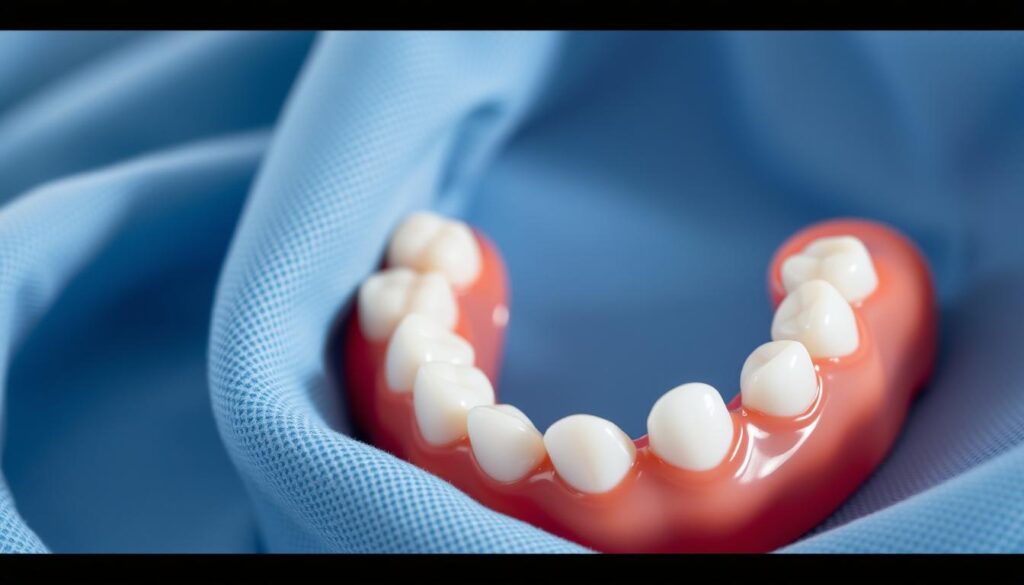
| Type of Prosthetic | Functionality | Stability | Ideal For |
|---|---|---|---|
| Full Dentures | Restores full arch | Removable | Total tooth loss |
| Partial Dentures | Restores missing teeth | Removable | Partial tooth loss |
| Dental Bridges | Bridges gaps | Fixed | One or more missing teeth |
| Dental Implants | Permanent replacement | Fixed | Single or multiple tooth loss |
Dental prosthetics are key in fixing oral function and boosting health for those without teeth. Knowing the different options like full dentures, partial dentures, dental bridges, and implants helps patients make smart choices. These choices are vital for looks and for eating, speaking, and keeping teeth clean.
For those looking into dental options in Turkey, finding skilled dentists is crucial. These experts can guide on the best options for each person. This ensures patients pick the right dental solution that fits their life and wants. Quality dental prosthetics can greatly improve function and confidence.
Dental prosthetics are artificial devices that replace missing teeth. They help restore oral function. Options include dentures, bridges, and implants, made from materials like porcelain and acrylic.
Dental prosthetics are key for oral health. They prevent teeth from shifting and reduce disease risk. They also improve function and boost confidence.
There are many dental prosthetics, like full dentures, partial dentures, bridges, and implants. Each is tailored to the patient's needs, offering removable or fixed options.
Full dentures replace all lost teeth. They sit on the gums. There are conventional and immediate types, made before or after tooth removal.
Partial dentures fit those with some missing teeth. They have replacement teeth on a gum-colored base. They restore function and look, preventing teeth from shifting.
Dental bridges replace missing teeth by attaching to healthy teeth. They improve chewing and speech. They also stop teeth from moving.
Dental implants are advanced solutions. They involve titanium posts in the jawbone, acting as roots. After integration, crowns are attached, offering a stable, permanent solution.
Keeping dental prosthetics clean is crucial. For removable ones, daily cleaning is key. Fixed ones, like implants, need careful brushing and flossing to avoid plaque and maintain health.
Periodontal surgery is a key part of dental care. It treats gum disease and related issues that harm tooth support. This surgery is vital for fixing gum health and stopping tooth loss.
For those with severe gum disease, surgery is often needed. It helps achieve better oral hygiene. In Turkey, dental tourism is growing, making it important to know about periodontal procedures.
Patients should talk to their dentists about surgery options. They should also learn about pre- and post-operative care.
Periodontal surgery is a key treatment for severe gum disease that doesn't respond to other treatments. It's needed when gum damage is too deep for simple fixes. Signs that you might need surgery include bad breath, swollen or bleeding gums, and deep spaces between your teeth.
When gum inflammation and infection get too far, surgery is often the only solution. This is especially true if you're in constant pain. Without surgery, your teeth could become loose or even fall out, making it crucial to treat the problem.
There are many periodontal procedures, each for different gum disease needs. These include:
People with advanced gum disease, loose teeth, or those not helped by simple treatments might need surgery. A dentist will check your mouth to see if you're a good candidate for periodontal surgery.
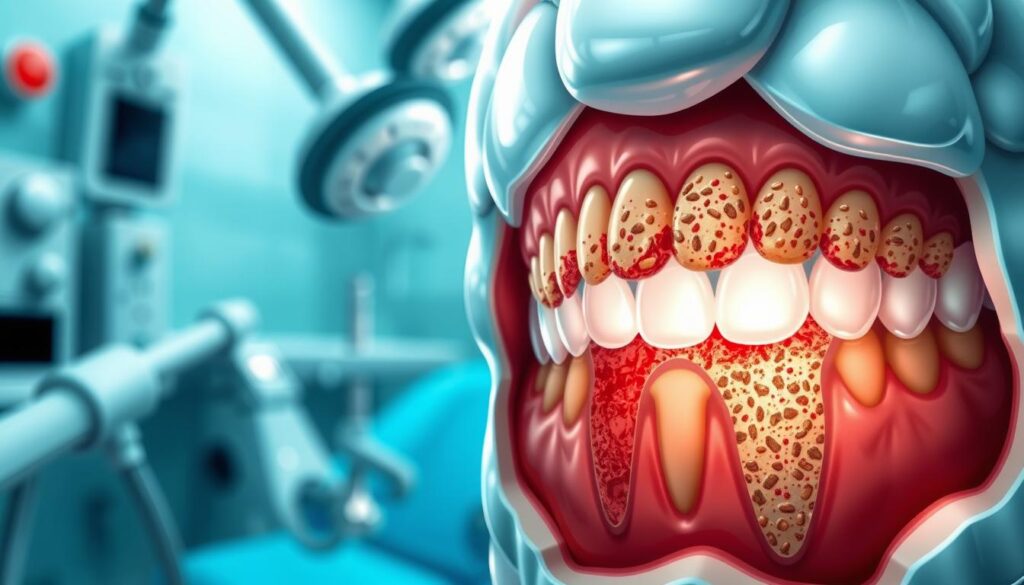
Periodontal surgery is a detailed method to fix gum health. It starts with a check-up by a skilled periodontist. They look at the patient's gum condition. Then, they might use local or general anesthesia to keep the patient comfortable.
They clean out infected pockets, reattach gums, or even graft bone. This is needed based on the patient's specific situation.
During the surgery, the dentist uses precise methods to fix gum problems. After giving anesthesia, they do what's needed for the patient. This might include:
These steps help fight gum disease and make sure teeth stay stable.
Recovery time from periodontal surgery varies. But, most people see improvement in a few days to weeks. Swelling and pain are common, but can be managed with medicine.
It's important to follow the dentist's advice on diet and oral care. Regular check-ups with the dentist are also key. They help track healing and make sure the medicine is working.
The main benefits of gum surgery are better gum health, less chance of tooth loss, and improved oral hygiene. Many patients feel more confident with their gums after surgery. But, there are risks to consider:
Knowing the benefits and risks helps patients make better choices for their dental health.

Periodontal surgery is very important for treating advanced gum disease and improving oral health. For those in Turkey, knowing about their surgical options is key. Understanding the need for these surgeries and the recovery process helps a lot.
Learning about the risks and benefits of dental surgeries helps people make better choices for their teeth. This knowledge is vital in the fight against gum disease. It shows how important it is to take care of your health.
Regular dental visits and good oral hygiene are key to avoiding gum disease. This helps prevent the need for surgery. Keeping your gums healthy is essential for your overall well-being and to avoid future problems.
Periodontal surgery is a dental procedure for gum disease. It helps restore teeth support. It's used when non-surgical treatments fail.
You might need it if you have bad breath, swollen gums, or bleeding. These signs mean your gum disease is severe.
Common procedures include scaling, flap surgery, and bone grafting. They clean, access, and rebuild gum health.
It's for those with advanced gum disease or tooth mobility. Your dentist will decide based on your condition.
Expect a thorough check-up and anesthesia. The surgery may include gum reattachment, pocket cleaning, or bone grafts.
Recovery takes a few days to weeks. You might feel pain and swelling. Follow your dentist's care instructions for healing.
Benefits include better gum health and less tooth loss risk. Risks include infection, bleeding, or anesthesia reactions. Knowing these helps you decide.
Follow your dentist's care, practice good oral hygiene, and see your dentist regularly. This prevents gum disease return.
Bonding treatment is a big hit in cosmetic dentistry, especially in Turkey. It's known for making smiles better with little fuss. This method uses a tooth-colored resin to fix things like stains, chips, and gaps.
It's a fast and affordable way to make teeth look great again. Many people choose it because it's quick and doesn't cost a lot. Plus, it's often the first step towards bigger fixes.
Dental bonding is a common cosmetic dentistry procedure. It makes teeth look better quickly and effectively. It fixes small issues with a tooth-colored resin, improving both looks and function.
The dental bonding definition is a cosmetic method. It uses a strong, tooth-like resin on a tooth. It fixes problems like chips, gaps, and color issues, making your smile look natural.
The bonding process starts with tooth preparation. The dentist cleans the tooth and uses an etching solution to make the enamel rough. This helps the resin stick better.
Then, the dentist applies the dental resin. They shape it and use a special light to harden it fast. This whole step usually takes 30 to 60 minutes per tooth.
Dental bonding has many uses, making it great for cosmetic uses. It's often used for:
In restorative dentistry, bonding does more than just look good. It also helps teeth work better. Many dentists suggest bonding in Turkey for those wanting to improve their smile without big surgeries.
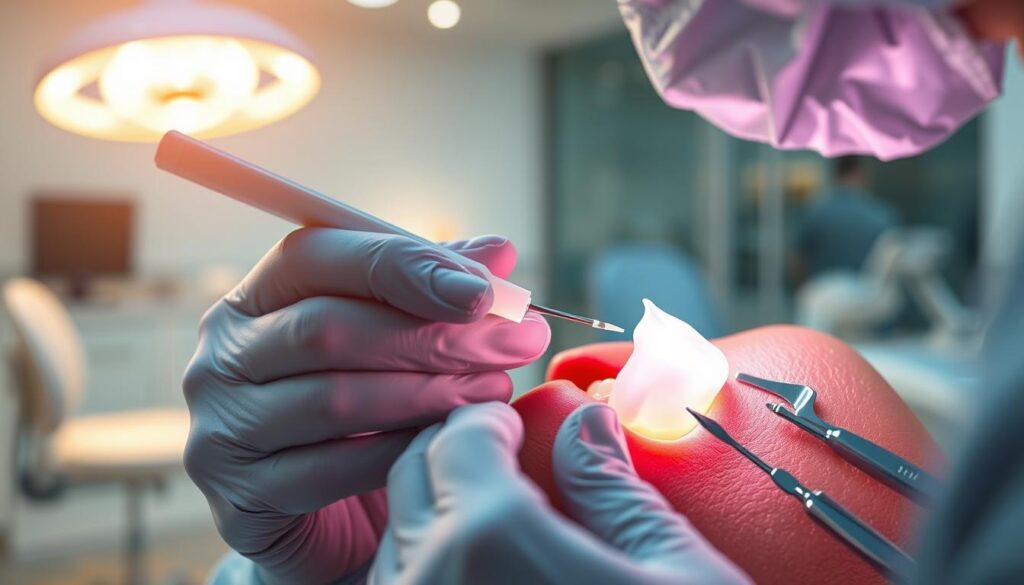
Bonding treatment has many benefits that make it great for your smile and easy to get. It's quick and effective, making it a top choice for many. Here are the main advantages of bonding treatment.
Bonding treatment is known for its quick beauty boost. The material used can match your teeth perfectly, blending in seamlessly. This leads to a smile that looks natural and boosts your confidence.
It's perfect for those wanting a better smile without long, complicated procedures.
Bonding is super convenient. It's often done in just one visit, so you can get back to your day quickly. This is great for people in Turkey with busy lives.
It's faster than other treatments like crowns or orthodontics, making dental care easier to fit into your schedule.
Bonding is also a budget-friendly option. It's cheaper than veneers or crowns, which is a big plus for those watching their budget. Plus, it needs little maintenance, making it a smart choice for your wallet and smile.

| Benefit | Bonding Treatment | Other Cosmetic Procedures |
|---|---|---|
| Aesthetics | Natural color matching | Multiple stages needed for color matching |
| Procedure Time | Single visit | Multiple appointments required |
| Cost | Affordable | Generally more expensive |
| Maintenance | Minimal follow-up needed | Regular maintenance required |
Bonding treatment offers many benefits for those wanting to improve their smile. It gives quick and easy results, perfect for busy people. Plus, it's affordable, making it a great choice for those on a budget.
In Turkey, bonding is a great option for dental improvements. It not only looks good but also helps keep your teeth healthy for a long time. The benefits of bonding are clear, making it a smart choice for a brighter smile.
Dental bonding is a cosmetic dentistry procedure. It uses a tooth-colored resin to enhance a tooth's appearance and function. This method corrects minor imperfections and boosts dental aesthetics.
First, the tooth is cleaned and prepped. Then, an etching solution is applied to help the resin stick. The resin is applied and shaped, and a special light hardens it. This makes the process quick and easy.
Bonding fixes chipped or cracked teeth, closes gaps, covers discoloration, and lengthens short teeth. It's great for both cosmetic and minor restorative needs.
Bonding improves your smile right away, matching the tooth color for a natural look. It's fast, usually done in one visit, and cheaper than veneers or crowns.
Bonding is usually painless. Most don't need anesthesia, unless the tooth is decayed or they're anxious.
With good care, bonding can last several years. But, it depends on oral hygiene, diet, and where the tooth is.
Those with discolored, chipped, or misaligned teeth are good candidates. It's a quick, affordable, and non-invasive option.
Yes, bonding can be a temporary fix. It improves your smile and function until you decide on more extensive treatments.
The process of impacted tooth extraction is a key dental procedure. It helps solve problems with tooth impaction, especially with wisdom teeth. Impacted teeth can cause pain, infections, and affect the alignment of other teeth.
Knowing the steps of this dental procedure is key for good oral health. This article will explain what happens during the procedure. It will also cover important recovery tips for a smooth healing.
Knowing about impacted teeth is key to good dental health. These teeth, like wisdom teeth, can cause problems if not treated quickly.
Impacted teeth can't fully come into the mouth because of blockages. This often happens when there's not enough room in the jaw. Or, when other teeth get in the way. Wisdom teeth are the most common to get impacted, leading to serious issues.
The reasons for impacted teeth causes are varied. They include:
People with symptoms of tooth impaction need to watch out. Signs to look for are:
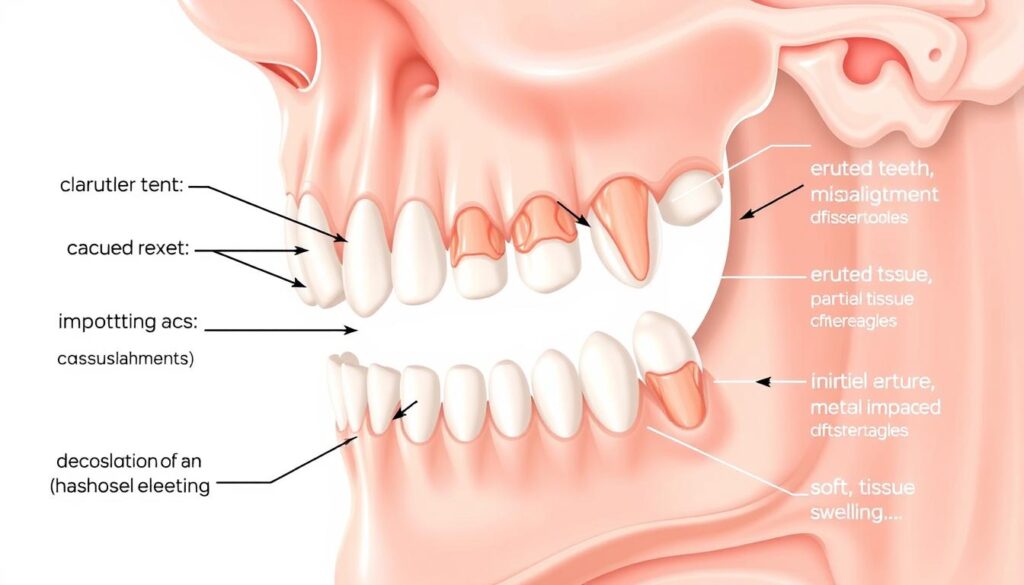
Spotting these signs early can help a lot. A quick trip to the dentist can stop bigger problems.
The process of removing impacted teeth involves several key steps. First, a dental consultation is needed to plan the treatment. This step helps the dentist understand the patient's dental history and the tooth's position.
In the dental consultation, the dentist explains the extraction process. Patients learn about anesthesia options and the procedure's length. This talk helps ease any worries and prepares them for what's next.
On the day of the extraction, the dentist will give anesthesia to keep the patient comfortable. Depending on the tooth's location, incisions might be needed. The dentist will then carefully remove the tooth, watching the patient's well-being closely.
After the extraction, proper care is crucial for a smooth recovery. Patients get instructions on managing pain, diet, and oral hygiene. Following these steps helps patients heal quickly and return to their normal lives.
Recovery after tooth extraction is a key part of dental care. Knowing the recovery time, managing pain, and watching for complications can make a big difference. It helps make the experience better for the patient.
The time it takes to recover from tooth extraction varies. It depends on the person and the complexity of the procedure. In the first few days, you might feel a lot of swelling and pain.
Most symptoms should go away within a week. But, it can take several weeks to fully heal. Your age, health, and how well you follow oral care advice also affect recovery time.
Managing pain after tooth extraction is crucial for a smooth recovery. You can use over-the-counter pain relievers or medicines your dentist prescribes. Besides medicine, there are home remedies that can help:
Using a mix of these methods can make your healing process more comfortable.
It's important to watch for signs of complications after tooth extraction. Catching them early can prevent bigger problems. Look out for:
By keeping an eye out for these signs, you can get help quickly. This supports your recovery after tooth extraction.

Impacted tooth extraction is a key dental procedure for good dental health. Knowing about tooth impaction helps patients make smart dental choices. Understanding the process and recovery tips can reduce anxiety and improve results.
Following post-extraction guidelines is crucial for safe healing. These steps help avoid complications and make recovery easier. Also, don't forget the importance of follow-up care. It helps catch any issues early and keeps your mouth healthy long-term.
Being proactive about dental health is important. Regular dental visits and post-procedure checks lead to better results. Stay in touch with your dentist to keep your teeth and gums healthy for the future.
Impacted tooth extraction is a surgery to remove teeth that don't fully come in. This often includes wisdom teeth. These teeth can cause pain, infections, and mess up the alignment of other teeth. Removing them helps keep your mouth healthy.
Several things can cause tooth impaction. These include not enough space in the jaw, teeth not lining up right, and genetics. Wisdom teeth are the most common to get impacted because there's not enough room.
Signs of impacted teeth include pain, swelling, trouble opening your mouth, and gum infections. Spotting these symptoms early is key to getting the right treatment.
At the pre-extraction visit, the dentist looks at your dental history and takes X-rays if needed. They also talk about the extraction process. This meeting helps plan the surgery.
The process starts with anesthesia to numb the area. Then, if needed, incisions are made. The dentist carefully pulls out the impacted tooth. How hard it is depends on where the tooth is under the gum.
After the extraction, you'll get advice on managing pain, what to eat, and keeping your mouth clean. Following these steps helps avoid infection and speeds up healing.
Recovery time varies. Swelling and pain usually go away in a few days. Healing can take from a few days to weeks, based on how complex the extraction was.
Managing pain might include medicines your dentist prescribes or over-the-counter options. You can also try ice packs at home. Always follow your dentist's advice for the best pain relief.
Keep an eye out for signs like too much bleeding, pain that lasts too long, infection signs (like fever or swelling), and any changes in your healing. If you notice these, see your dentist right away.
Sinus lifting, also known as sinus augmentation, is a key surgery. It boosts the upper jawbone, especially near the molars and premolars. This area is close to the maxillary sinus, making it hard to place dental implants because of bone shortage.
By raising the sinus floor and adding bone graft, sinus lifting creates a solid base for implants. It's great for those who lost bone due to gum disease, tooth removal, or certain body shapes. This method is vital for bringing back both function and beauty. Oral surgeons and periodontists usually do this, giving each patient the care they need.
With successful sinus augmentation, patients have a better shot at getting dental implants. This leads to better gum health.
Sinus lifting is a key part of implant dentistry. It helps many patients improve their dental health. This method tackles bone issues in the maxillary sinus area.
The goal of sinus lifting is to add bone volume in the upper jaw, near the maxillary sinus. It aims to prepare the area for dental implants when there's not enough bone. This involves lifting the sinus membrane and adding bone grafts for a strong base.
A successful sinus lift boosts the chance of implant success. It helps the implants integrate well into the jawbone.
Those with significant bone loss in the upper jaw are good candidates for sinus lifting. Ideal candidates have healthy sinuses and are generally healthy. A dental health check, including X-rays or CT scans, is needed to assess bone and sinus health.
People with bone loss from tooth extraction, gum disease, or birth defects often benefit. However, smokers or those with chronic conditions may need extra evaluation.
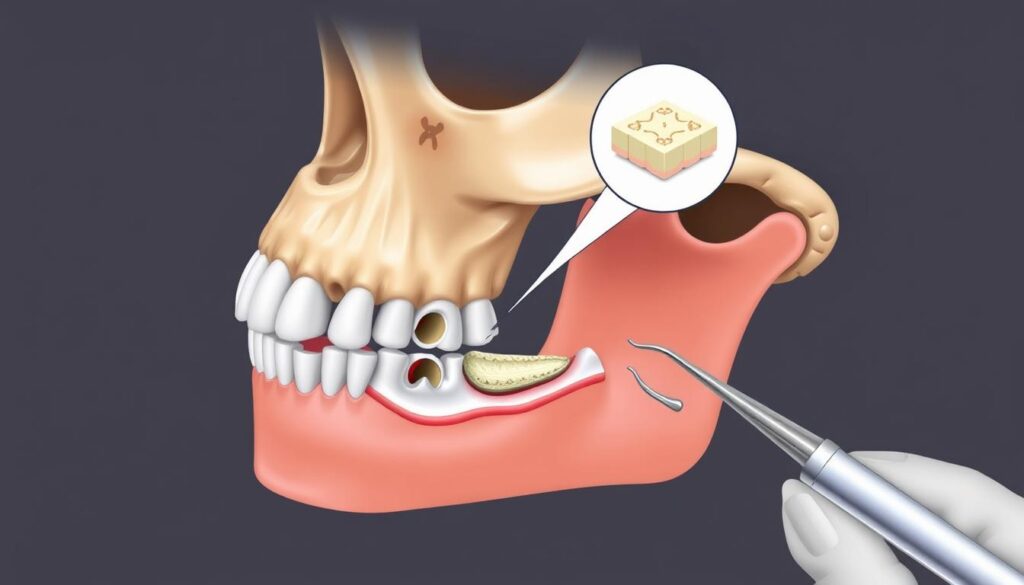
The sinus lifting procedure is a dental surgery that adds bone to the upper jaw. It's needed when there's not enough bone for implants. Knowing about this surgery is important for those thinking about it.
The procedure starts with checking the bone and sinuses. It's done under local anesthesia or sedation. A small cut is made in the gum to reach the bone.
Then, a small hole is made in the bone. The sinus membrane is gently moved up. Bone graft material is used to fill the space.
After the graft is in place, the cut is closed with stitches. This helps the graft heal and join with the bone.
Recovery from sinus lifting takes several weeks. Patients should avoid hard activities and movements that might hurt the area. They'll need to manage pain and take antibiotics to prevent infection.
Regular check-ups are key to track healing. It can take 4 to 6 months for the graft to fully integrate. Only then can implants be placed.
Like any surgery, there are risks with sinus lifting. These include infection, sinus membrane damage, and graft failure. Perforation might need more treatment.
Patients may also face swelling, bruising, or bleeding. These are common but usually manageable. Knowing these risks helps in making the right choice.
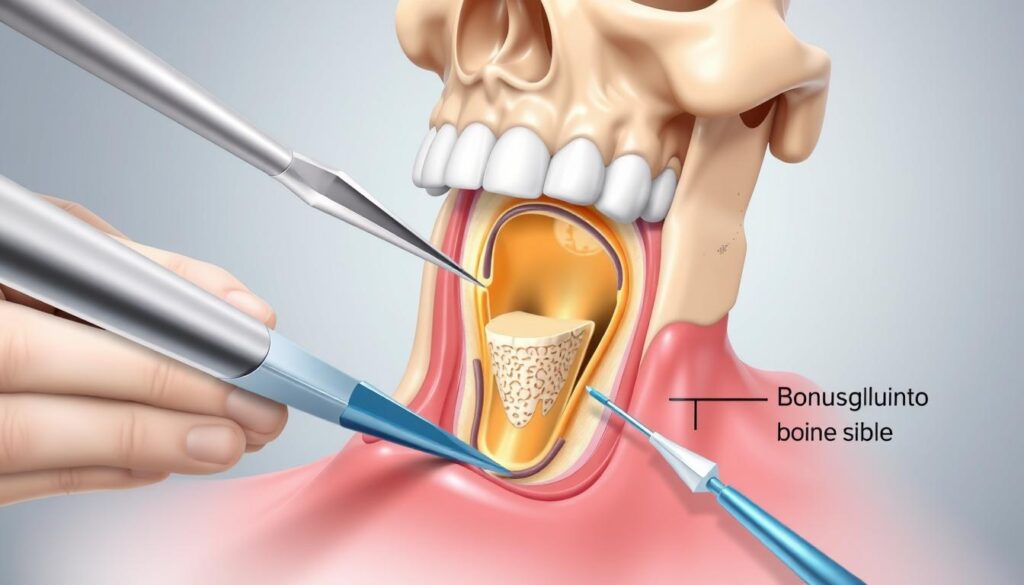
The sinus lifting procedure is key for those wanting to boost their upper jawbone. This is vital for dental implant success. It helps patients understand the process and its benefits.
Knowing how to care for yourself after the surgery and managing risks is important. A skilled doctor doing the procedure helps avoid problems. This makes the treatment more effective for bone growth.
Finally, sinus lifting is a step towards fixing smiles. It helps patients get back their smile's function and look. For those thinking about dental implants, knowing about this procedure is crucial for success.
Sinus lifting, also known as sinus augmentation, is a surgery. It aims to add bone in the upper jaw, especially in the maxillary sinus area. This is key for dental implants to work well.
People with bone loss in the upper jaw, especially in the back molar area, are good candidates. A dental health check, including imaging, is needed. It makes sure the sinus is healthy and there are no ongoing infections.
The procedure starts with a detailed check-up. Then, a gum incision is made. The sinus membrane is lifted, and bone graft material is placed. This creates a base for dental implants.
Recovery takes a few weeks. At first, patients should avoid hard work. Pain management and follow-up visits are crucial. Full healing takes several months.
Risks include infection and sinus membrane perforation. There's also a chance of not enough bone forming. Swelling and bruising are common but can be managed. Knowing these risks helps make informed decisions.
Sinus lifting adds bone to the upper jaw. This makes a stable place for dental implants. It greatly increases the chance of successful implant placement and integration.
Laminate veneers are a top choice in cosmetic dentistry for a flawless smile. They are thin, high-quality porcelain shells that cover the front of teeth. In Turkey, more people are choosing veneers for their affordability and quality.
These veneers can fix many issues like stains, gaps, and misalignment. They make teeth look better and boost confidence and beauty.
People looking to improve their smile often think about dental veneers. These solutions can change a smile for the better. Knowing what laminate veneers are and how they work helps in making the right choice for your teeth.
Laminate veneers are thin, custom-made shells for the front of teeth. They are made of porcelain or resin. They aim to make teeth look better without harming the natural tooth too much. The process is quick and leaves teeth looking natural and shiny.
Laminate veneers offer many benefits. Here are some:
Good candidates for veneers have healthy teeth but want to fix small issues. If your teeth are stained, worn, or chipped, veneers can help a lot. But, if you have big problems like decay or gum disease, you might need something else first. Talking to a dentist can help figure out if veneers are right for you.
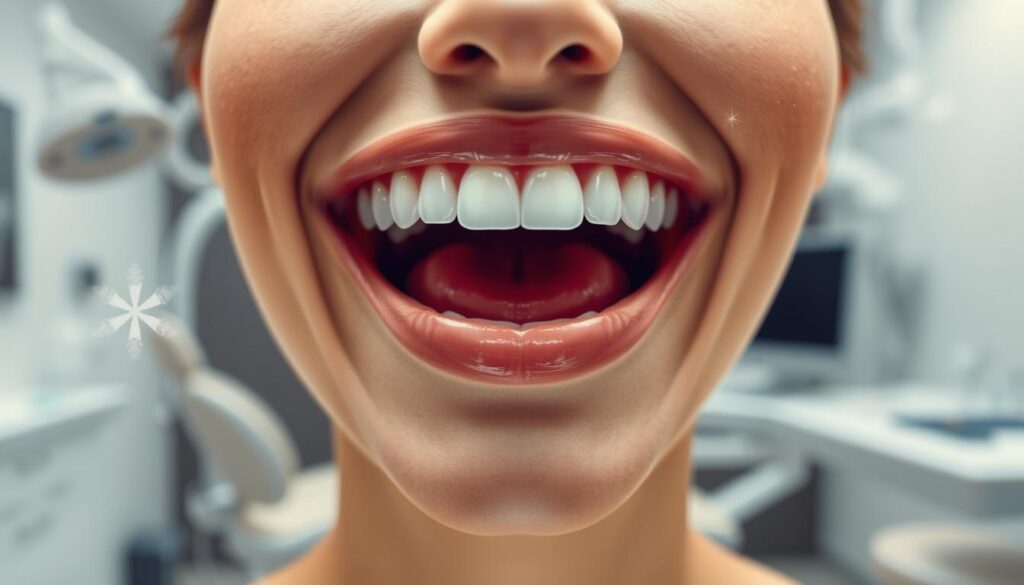
Laminate veneers are a great way to improve your smile. They look natural and fix many dental issues. Knowing what to expect is key for those thinking about veneers. The process includes planning, precise installation, and considering the costs.
Patients usually go to the dentist twice for veneers. The first time, they talk about what they want and check their teeth. The dentist might take X-rays and images to plan the next steps.
During this visit, the dentist will remove a thin layer of enamel. This is done to fit the veneers perfectly. The veneers are made in a lab based on the impressions taken.
The second visit is when the veneers are put on. This is the final step to change your smile.
Laminate veneers in Turkey are affordable without losing quality. Prices range from $200 to $500 per tooth. The cost depends on the dentist, clinic location, and veneer materials.
Comparing prices, Turkey is often cheaper for international patients. Clinics offer packages that include travel and stay. It's important to research and read reviews to find a good dentist.
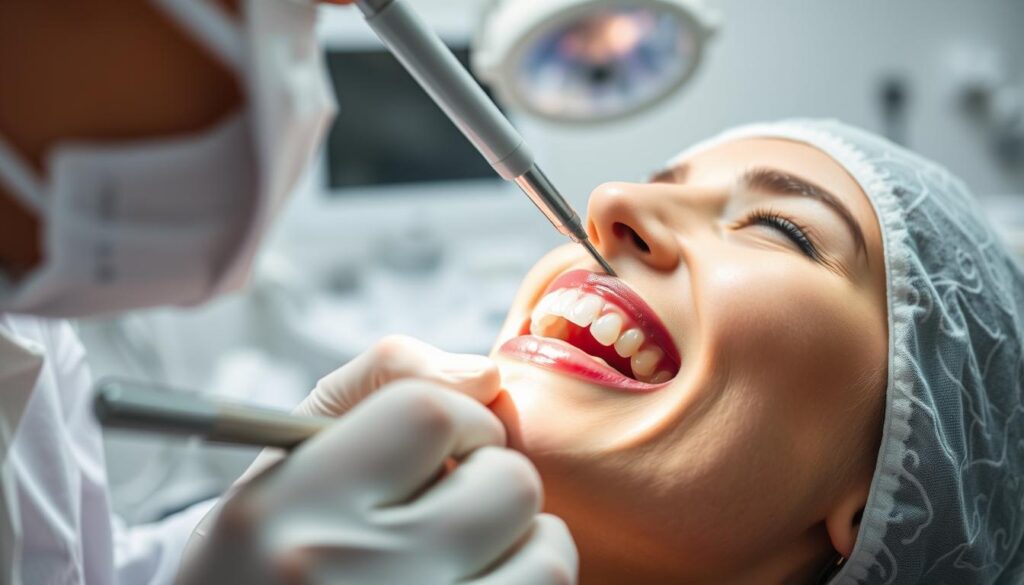
Laminate veneers are a great choice for those wanting a perfect smile without much hassle. They not only make your teeth look better but also work well. This makes them a favorite among people looking to improve their smile.
Turkey is becoming a top spot for dental tourism, especially for laminate veneers. It's affordable and you get top-notch care. This means you can get a new smile without spending too much.
Before making a decision, talk to a dentist who knows what they're doing. They can tell you if veneers are right for you. Getting veneers can give you a smile that lasts and boosts your confidence and happiness.
Laminate veneers, also known as dental veneers, are thin, custom-made shells. They are bonded to the front of teeth. Made from porcelain or resin, they improve tooth appearance by fixing discoloration, chips, and minor misalignments.
Laminate veneers offer a natural look and are durable. They resist stains well and can fix many dental issues. The process also preserves more of the natural tooth than crowns do.
People with healthy teeth and minor imperfections are ideal candidates. Those with stained, chipped, or slightly misaligned teeth benefit the most. It's crucial to consult a dentist to check if veneers are right for you.
The procedure takes two visits. First, the dentist prepares your teeth and takes impressions. Then, custom veneers are made in a lab.
In Turkey, laminate veneers cost between 0 to 0 per tooth. This is cheaper than in many other countries. Prices depend on the clinic, dentist, and materials used. Researching clinics and reading reviews is wise.
No, laminate veneers are not reversible. Enamel is removed during preparation. But, they are a long-term solution when cared for properly.
With good care, laminate veneers last 10 to 15 years. Regular dental visits and avoiding bad habits can help them last longer.
Laminate veneers work well for many moderate issues. But, they're not for severe problems like extensive decay or major misalignment. Seek other treatments first.